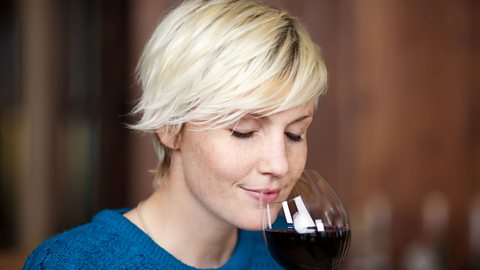The total beginner's guide to tasting wine like a pro
Follow these tips and you’ll soon be sniffing, swilling and slurping like an expert…

When you’re in a supermarket, pub or restaurant, do you feel stumped when presented by the selections of wine on offer? There’s just so much choice.
Whether it‚Äôs red, ros√© or white, sweet or dry, fruity or savoury, full-bodied or light ‚Äď there are so many options, and sometimes, the language can make things even more confusing. Do you really taste the ‚Äėcut grass‚Äô notes that the label proclaims? Do you find yourself trying to find the hint of blackcurrant but fail?
Professional wine tasting teacher, reveals her top tips to help you feel more confident about choosing wine that matches your mood, your food and your tastes.
Don’t be put off by wine tasting stereotypes
Think wine tasting is just something for the rich and famous? Think again! ‚ÄúIt‚Äôs getting more accessible and the basics are pretty straightforward,‚ÄĚ says Anjali.
‚ÄúDon‚Äôt worry about getting lots of wine tasting equipment, a bottle opener and a couple of wine glasses is all you need. Remember, it‚Äôs your opinion that matters most ‚Äď if you like the wine, then it‚Äôs good wine!‚ÄĚ
Understanding the basics
‚ÄúWine is made by converting sweet grape juice into alcohol (and Co2) by a process called fermentation,‚ÄĚ explains Anjali.
‚ÄúThe two main things that distinguish one wine from another are grape variety and climate. For some wines it will be easy to see what grape variety is used as it will be written on the bottle,‚ÄĚ says the expert, while pointing out a few examples: ‚ÄúChardonnay, Merlot and Sauvignon Blanc are all names of grapes. These varieties, like apples in a supermarket, will have different characteristics,‚ÄĚ says Anjali who works for the Wine & Spirit Education Trust.
For other wines ‚Äď including Burgundy and Rioja, the type of wine is named after a region. This is especially common with wines from France, Italy and Spain. ‚ÄúHere you might have to look up what grapes are used,‚ÄĚ says Anjali before adding: ‚ÄúAll wines will tell you where they are from on the label. It can be as big as the country or as small as a tiny village.
‚ÄúWines from a cooler climate ‚Äď like parts of France, Germany or the UK, will make wines that are generally fresher and lighter, whereas a warm climate will make wines that are richer and fuller. One isn‚Äôt better or worse than the other, they‚Äôre just different!‚ÄĚ
The basic types of wine:
Red: ‚ÄúA wine made with black grape varieties like Merlot, Syrah or Cabernet Sauvignon. The black grape skins soak in the liquid imparting a red colour. Red wines can dry out your mouth, the reason being, the grape skins include the chemical compound tannins which are very bitter. They are also present in black tea which is why if you've ever over-brewed a cup, it can leave a sticky, dry feeling on your palate ‚Äď that's the tannins.‚ÄĚ
White: ‚ÄúA wine usually made with white grape varieties like Chardonnay, Sauvignon Blanc or Riesling. Just the fleshy pulp inside a grape is used to make these, so there is no colour from the skins.‚ÄĚ
Ros√© : ‚ÄúSort of a weak tea version of red wine! The skins of black grapes are just soaked for a very short time in the fermenting juice, so a tiny bit of colour is imparted, making the wine pink.‚ÄĚ
Dessert: ‚ÄúA wine with lots of natural sugar! It will taste very sweet and thicker and heavier when you taste it.‚ÄĚ
Fortified: ‚ÄúWine that has had extra alcohol added to it ‚Äď usually this is a spirit. It‚Äôs historically been done as a method to preserve a wine.‚ÄĚ
Sparkling: ‚ÄúWine that has had Co2 trapped and dissolved in the wine [or added to it], giving it bubbles, or sparkle.‚ÄĚ
Related stories
Now it’s time to taste wine

‚ÄúPour out a 50ml measure in a wine glass ‚Äď this is the equivalent of a double shot. There should be enough space that you can swirl the wine around without getting it all over your carpet!‚ÄĚ This will help release the aromas explains Anjali. "So, no flute glasses!" says the wine tasting instructor.
Anjali advises following the . ‚ÄúHere you need to think about the appearance, nose and palate of a wine.‚ÄĚ
Appearance: ‚ÄúHave a look at the wine, is it red, white, ros√©? Can you see any bubbles?‚ÄĚ Then, look at how deep or light the colours are as this could indicate what to expect from the wine.
Nose: ‚ÄúGive the wine a swirl and a smell, what aromas are there? All wines have fruity aromas ‚Äď look for citrus, stone or tropical fruits in whites and red or black berry fruits in reds. Then, is there anything else? Spicy aromas like vanilla or clove might indicate the wine has been stored inside an oak barrel.‚ÄĚ
Palate: ‚ÄúThis is what you can taste when you sip the wine. Try to get it all around your mouth ‚Äď like mouthwash! Consider: Are there any other flavours you can taste as well as the aromas you could smell? How light or heavy does it feel? Can you taste any sweetness? Are you finding it particularly mouth-watering and refreshing? Is the alcohol warming up your palate or is it not very noticeable? For reds you might pick up some bitterness ‚Äď ask how much is it drying out your mouth?‚ÄĚ
Swallow the wine (or spit it out): ‚ÄúI spit it when I‚Äôm working,‚ÄĚ says Anjali but when you‚Äôre at home, swallowing the wine can actually be beneficial ‚Äď and not just because it means the wine doesn‚Äôt go to waste! ‚ÄúYou might feel different alcohol levels a bit better towards the back of your palate, near your throat. It‚Äôs that warming feeling you might experience if you've had a spirit. See if you can taste that.‚ÄĚ
The finish: ‚ÄúThis is the length of time the positive flavours linger on the palate. For example, how long does the taste of blackcurrant or strawberry that you could smell last? The longer you can taste it after you‚Äôve swallowed or spat out the wine, the higher the quality.‚ÄĚ
Comparing wines

If you can, tasting two or more at the same time is useful, says Anjali. ‚ÄúThat way you can really see how different some wines can be from each other.‚ÄĚ If you‚Äôre tasting wine with a friend or two and so can splash out on a couple of bottles, what should you opt for?
‚ÄúIt can be useful to taste two wines made from the same grape varieties but from different places [in the world], that way you can see what is similar and what is different about them.‚ÄĚ
Anjali explains the following are good to try (and all will be affordable and available from supermarkets):
- Chablis vs. Chardonnay from Australia or California
- Sancerre vs. New Zealand Sauvignon Blanc
- Bordeaux vs. Merlot from Chile
- Red Burgundy vs. Pinot Noir from Chile or New Zealand
- Rosé from Provence vs. White Zinfandel from California
Glossary of wine phrases
Full/medium/light-bodied: ‚ÄúThis relates to the weight of the wine. Compare skimmed milk to whole milk, this is the equivalent of light and full-bodied wine.‚ÄĚ
Dry: ‚ÄúThe majority of wines are dry. This means all the sugar in the grape juice has been converted into alcohol. Just because it smells sweet doesn‚Äôt mean it will be!‚ÄĚ
Off Dry: ‚ÄúA little bit of sugar is left in the wine, so it might taste a little bit sweet. Some Rieslings are off dry.‚ÄĚ
Medium: ‚ÄúThe sweetness you taste in this wine is noticeable. A few ros√©s including White Zinfandel are medium in sweetness.‚ÄĚ
Sweet: These wines are very sweet! They also taste richer and heavier on the palate. They are also known as dessert wines. Examples include Sauternes or Port.‚ÄĚ
Fruity: All wines smell fruity in some way, but some wines have additional aromas like spice from being stored in an oak barrel, or savoury aromas from ageing. Fruity wines are usually young and ‚Äėunoaked‚Äô.‚ÄĚ
Savoury: ‚ÄúIf a wine has spent time ageing it might become more savoury. Have a look at the vintage ‚Äď the year written on the bottle ‚Äď to get an idea of the age of the wine. The older it is, the more likely it will begin to have savoury aromas like earth, mushroom, leather or nuts.‚ÄĚ
Aromatic: ‚ÄúThis wine has intense aromas that are often quite perfumed, floral or herbaceous. Examples include Riesling or Sauvignon Blanc.‚ÄĚ
What to expect from different wines
While the list below isn't exhaustive, these are the most commonly talked about grapes and regions. Once you've got your head around these, why not investigate others.
Grapes
Syrah: ‚ÄúA full-bodied red wine with aromas of blackberry and peppery spice.‚ÄĚ
Cabernet Sauvignon: ‚ÄúA red wine with high levels of tannins and acidity ‚Äď aromas of blackcurrant and sometimes a herbaceous or minty aroma.‚ÄĚ
Pinot Noir: ‚ÄúA delicate and fresh red wine with aromas like strawberry and red cherry.‚ÄĚ
Merlot: ‚ÄúA plummy red wine with smooth tannins.‚ÄĚ
White Zinfandel: ‚ÄúA medium sweet ros√© wine with aromas of candied strawberries and watermelon.‚ÄĚ
Sauvignon Blanc: ‚ÄúAn aromatic white wine with strong aromas of passion fruit, cut grass and grapefruit and very high acidity.‚ÄĚ
Chardonnay: ‚ÄúThe style of Chardonnay depends very much on the climate it‚Äôs grown in. Somewhere cool, like Chablis, it will have fresh citrussy aromas, somewhere warm, like California, it will have aromas of pineapple, mango and maybe some spice from oak.‚ÄĚ
Riesling: ‚ÄúAnother aromatic grape which can have complex aromas of white flowers and lemons. It‚Äôs not always sweet but it can be!‚ÄĚ
Malbec: ‚ÄúA medium or full-bodied red wine with aromas of plums and vanilla.‚ÄĚ
Regions
Chablis: ‚ÄúA wine from northern France with refreshing high acidity and aromas of lemons and green apple.‚ÄĚ
Bordeaux: ‚ÄúA red wine from south-west France with aromas of black fruits like black plum and blackberry and maybe some cedar and clove.‚ÄĚ
Red Burgundy [made from the Pinot Noir grape]: ‚ÄúA delicate French (mid-East) red wine ‚Äď aromas of strawberry, cranberry and red cherries and lower levels of tannin.‚ÄĚ
White Burgundy [made from the Chardonnay grape]: ‚ÄúA full-bodied white wine ‚Äď look for aromas of lemon, peach, smoke and vanilla.‚ÄĚ
Sancerre: ‚ÄúA fresh white wine from Central France made from Sauvignon blanc grape. It has aromas of lemons and cut grass.‚ÄĚ
Rioja: ‚ÄúA red wine from Spain which can have aromas of strawberry and vanilla from oak.‚ÄĚ
Barolo: ‚ÄúA wine from North-West Italy that needs some time maturing for it to be at its best. It has very high, mouth-drying tannins that will soften over time and aromas of dried strawberry, herbs and earth.‚ÄĚ
Priorat: ‚ÄúThis wine comes from a region in Spain with very old vines. These vines produce very small amounts of grapes that are very intense.‚ÄĚ
Originally published May 2022